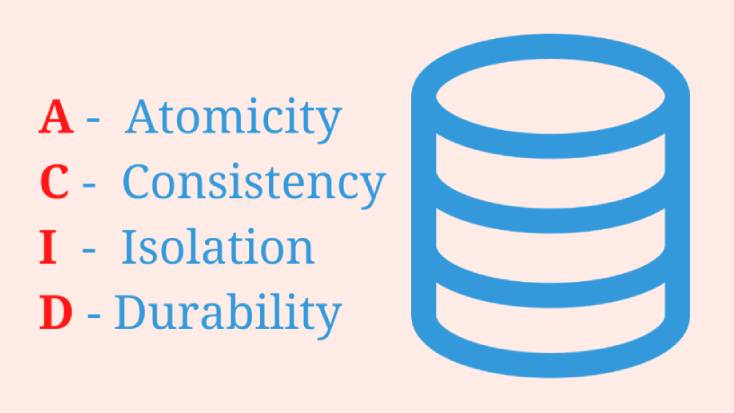Table of Contents
Introduction
In the transaction processing framework, the ACID abbreviation refers to a transaction’s four chief and essential properties. These are atomicity, consistency, isolation, and durability.
In its entirety, the ACID properties of transactions provide a mechanism in DBMS to ensure the consistency and perfection of any database. Transactions access data using read-and-write operations. Certain properties are followed around the transaction process to maintain consistency in a database. These are called ACID properties.
ACID Properties:
ACID features breaks down into four properties: atomicity, consistency, isolation, and durability.
Atomicity: Atomicity refers to the success or failure of a transaction. It is an in-or-out operation. Although formed of multiple steps, those steps are considered a single operation or unit. We have the following two operations here:
Commit: In case a transaction commits, the amended changes are noticeable. Hence, atomicity is known as the ‘All or nothing rule.’
Abort: In case a transaction aborts, the amended changes are inconspicuous.
Consistency: Consistency means maintaining the integrity constraints so that any given database stays consistent throughout the transaction process. Transactional consistency confirms that corruption or errors in any data do not create unintended significance for the integrity of the table.
Isolation: Isolation ensures the simultaneous happening of multiple transactions without a database, leading to a state of inconsistency. A transaction takes place independently, i.e., without any intervention.
Any alterations in a particular transaction would never be visible to the other transactions, except this specific change in this transaction has been passed or written to the memory.
Durability: The final ACID property denotes the determination of committed transactions. Transactions & database modifications are not set aside in volatile memory but are saved to permanent storage, such as disks. This foils data loss during system failure, such as a power outage.
Importance of ACID Properties:
ACID transactions ensure the utmost possible data consistency & integrity. They provide that data never drops into an inconsistent state because of the impartial completion of an operation.
For instance, without ACID transactions, writing some data to a database table, but the power went off surprisingly. Subsequently, not all the data may be saved. Therefore, the database is in an inconsistent state that is complicated and time-consuming to recover.
Additional Important Points:
Atomicity: Transaction Manager
Consistency: Application Programmer
Isolation: Concurrency Control Manager
Durability: Recovery Manager
Generally, ACID properties provide a structure for ensuring data consistency, integrity, and reliability in DBMS. They make sure the execution of transactions is reliable and consistent, even in the occurrence of system failures, network issues, or other problems. These properties make DBMS a reliable & efficient tool for managing data in modern organizations.
Implementation of ACID Transactions:
Considerably, the most known implementation of ACID transactions completes through locks. This means data is inaccessible by another transaction until a transaction completes or fails to ensure atomicity, isolation, and consistency.
Databases habitually implement write-ahead logs to guarantee durability. Furthermore, transactions are stored in transaction logs, and once they are saved to a separate source, their implementation occurs in the actual database.
In case of failure of the system mid-transaction, the transaction is either rolled back or continued from where the transaction log left off.
Advantages & Disadvantages of ACID Properties in DBMS:
ACID adherence offers multiple benefits:
- ACID properties ensure the data stays consistent and accurate after the execution of any transaction.
- ACID properties preserve the integrity of the data by making certain any changes to the database are everlasting and cannot be lost.
- ACID properties help manage multiple transactions occurring simultaneously by foiling any interference amongst them.
- The properties ensure that during failure or crash, the system can recover the data up to the point of failure or crash.
ACID transactions do carry negative consequences:
- Enforcing its properties can introduce a performance overhead, as it often requires locking, logging, and other mechanisms to ensure data consistency and durability. These operations can slow down database transactions, particularly in high-concurrency environments.
- Its properties can make it more challenging to scale a DBMS horizontally, especially in distributed systems. Achieving high levels of availability and scalability while maintaining strict ACID compliance can be complex and expensive.
- ACID-compliant systems can be susceptible to deadlocks and contention issues, as transactions may lock resources until completion. This can reduce throughput and performance bottlenecks, particularly in systems with many concurrent users and high write loads.
- Designing, implementing, and maintaining a DBMS that adheres to ACID properties can be complex and time-consuming. Developers must carefully consider transaction boundaries, locking strategies, and recovery mechanisms, which can slow application development and increase costs.
Conclusion:
In conclusion, ACID (Atomicity, Consistency, Isolation, Durability) properties in DBMS are vital for ensuring data consistency & integrity. They provide a strong foundation for maintaining data consistency and durability.
However, implementing ACID properties can introduce performance overhead, scalability challenges, and complexity in development. Relaxing ACID constraints in favor of NoSQL or other approaches may be considered in situations where high performance and scalability are top priorities.
Nevertheless, for applications where data integrity and consistency are paramount, [ACID] remains a fundamental structure to ensure that database transaction handling is precise and trustworthy.

